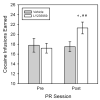Continuous intracerebroventricular infusion of the competitive NMDA receptor antagonist, LY235959, facilitates escalation of cocaine self-administration and increases break point for cocaine in Sprague-Dawley rats
- PMID: 17716714
- PMCID: PMC2712253
- DOI: 10.1016/j.pbb.2007.07.009
Continuous intracerebroventricular infusion of the competitive NMDA receptor antagonist, LY235959, facilitates escalation of cocaine self-administration and increases break point for cocaine in Sprague-Dawley rats
Abstract
Although escalation of consumption is an important characteristic of cocaine dependence, the neurobiological mechanisms that mediate this phenomenon have not been fully described. In this study, we used male, Sprague-Dawley rats to measure the effects of acute and continuous intracerebroventricular (ICV) administration of the competitive NMDA receptor antagonist, LY235959, on cocaine self-administration behavior under various schedules of reinforcement and access conditions. Single ICV infusions of LY235959 (0.03-0.3 microg/5 microl) produced dose-dependent and statistically significant decreases in the number of cocaine infusions earned under a progressive ratio schedule of reinforcement. In a second experiment, vehicle or LY235959 (0.2-0.3 microg/day) was continuously administered ICV to rats via surgically-implanted subcutaneous osmotic minipump/intracranial cannula assemblies. Both vehicle- and LY235959-treated rats significantly escalated cocaine self-administration over the 10 long access sessions; however, rats treated with LY235959 escalated cocaine self-administration faster and to a greater degree than vehicle-treated rats. There was a statistically significant increase in cocaine infusions earned under the PR schedule in LY235959-treated rats, but not vehicle-treated rats, after 10 long access cocaine self-administration sessions. These data support the hypothesis that escalation of cocaine consumption is mediated by hypo-glutamatergic tone in the central nervous system and this facilitation of escalation is associated with an increase in motivation to respond for cocaine.
Figures



Similar articles
-
Continuous exposure to dizocilpine facilitates the acquisition and escalation of cocaine consumption in male Sprague-Dawley rats.Drug Alcohol Depend. 2015 Feb 1;147:137-43. doi: 10.1016/j.drugalcdep.2014.11.027. Epub 2014 Dec 9. Drug Alcohol Depend. 2015. PMID: 25523326 Free PMC article.
-
Continuous exposure to the competitive N-methyl-D: -aspartate receptor antagonist, LY235959, facilitates escalation of cocaine consumption in Sprague-Dawley rats.Psychopharmacology (Berl). 2007 Apr;191(2):341-51. doi: 10.1007/s00213-006-0661-3. Epub 2007 Jan 16. Psychopharmacology (Berl). 2007. PMID: 17225167
-
Effects of the competitive N-methyl-D-aspartate receptor antagonist, LY235959 [(-)-6-phosphonomethyl-deca-hydroisoquinoline-3-carboxylic acid], on responding for cocaine under both fixed and progressive ratio schedules of reinforcement.J Pharmacol Exp Ther. 2005 Oct;315(1):449-57. doi: 10.1124/jpet.105.086355. Epub 2005 Jul 15. J Pharmacol Exp Ther. 2005. PMID: 16024734
-
Continuous exposure to dizocilpine facilitates escalation of cocaine consumption in male Sprague-Dawley rats.Drug Alcohol Depend. 2014 Jan 1;134:38-43. doi: 10.1016/j.drugalcdep.2013.09.005. Epub 2013 Sep 14. Drug Alcohol Depend. 2014. PMID: 24103127 Free PMC article.
-
How to make a rat addicted to cocaine.Prog Neuropsychopharmacol Biol Psychiatry. 2007 Nov 15;31(8):1614-24. doi: 10.1016/j.pnpbp.2007.08.028. Epub 2007 Aug 28. Prog Neuropsychopharmacol Biol Psychiatry. 2007. PMID: 17888555 Free PMC article. Review.
Cited by
-
Continuous exposure to dizocilpine facilitates the acquisition and escalation of cocaine consumption in male Sprague-Dawley rats.Drug Alcohol Depend. 2015 Feb 1;147:137-43. doi: 10.1016/j.drugalcdep.2014.11.027. Epub 2014 Dec 9. Drug Alcohol Depend. 2015. PMID: 25523326 Free PMC article.
-
Behavioral economic assessment of price and cocaine consumption following self-administration histories that produce escalation of either final ratios or intake.Neuropsychopharmacology. 2009 Feb;34(3):796-804. doi: 10.1038/npp.2008.195. Epub 2008 Oct 29. Neuropsychopharmacology. 2009. PMID: 18971927 Free PMC article.
-
Attenuation of morphine antinociceptive tolerance by a CB(1) receptor agonist and an NMDA receptor antagonist: Interactive effects.Neuropharmacology. 2010 Feb;58(2):544-50. doi: 10.1016/j.neuropharm.2009.08.005. Epub 2009 Aug 21. Neuropharmacology. 2010. PMID: 19699755 Free PMC article.
-
Performance on a strategy set shifting task in rats following adult or adolescent cocaine exposure.Psychopharmacology (Berl). 2014 Dec;231(23):4489-501. doi: 10.1007/s00213-014-3598-y. Epub 2014 May 7. Psychopharmacology (Berl). 2014. PMID: 24800898 Free PMC article.
-
Parsing the Addiction Phenomenon: Self-Administration Procedures Modeling Enhanced Motivation for Drug and Escalation of Drug Intake.Drug Discov Today Dis Models. 2008 Winter;5(4):217-226. doi: 10.1016/j.ddmod.2009.04.001. Drug Discov Today Dis Models. 2008. PMID: 20216935 Free PMC article.
References
-
- Ahmed SH, Kenny PJ, Koob GF, Markou A. Neurobiological evidence for hedonic allostasis associated with escalation in cocaine use. Nat Neurosci. 2002;5:625–626. - PubMed
-
- Ahmed SH, Koob GF. Transition from moderate to excessive drug intake: change in hedonic set point. Science. 1998;282:298–300. - PubMed
-
- Ahmed SH, Koob GF. Changes in response to a dopamine receptor antagonist in rats with escalating cocaine intake. Psychopharmacology. 2004;172:450–454. - PubMed
-
- Allen RM, Carelli RM, Dykstra LA, Suchey TL, Everett CV. Effects of the competitive NMDA receptor antagonist, (−)-6-phosphonomethyl –deca-hydroisoquinoline-3-carboxylic acid (LY235959), on responding for cocaine under both fixed and progressive ratio schedules of reinforcement. J Pharmacol Exp Ther. 2005;315:449–457. - PubMed
-
- Allen RM, Dykstra LA. N-methyl-D-aspartate receptor antagonists potentiate the antinociceptive effects of morphine in squirrel monkeys. J Pharmacol Exp Ther. 2001;298:288 – 297. - PubMed
Publication types
MeSH terms
Substances
Grants and funding
LinkOut - more resources
Full Text Sources
Medical
Research Materials

